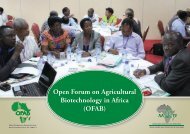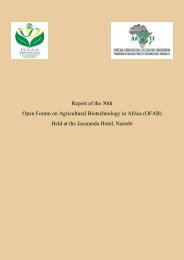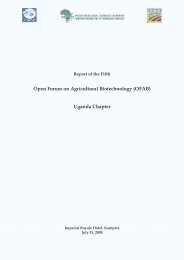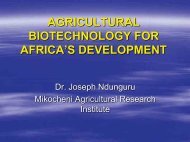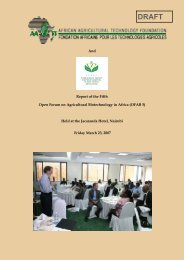Aflatoxin in Food: What Role for Biotechnology? - OFAB
Aflatoxin in Food: What Role for Biotechnology? - OFAB
Aflatoxin in Food: What Role for Biotechnology? - OFAB
You also want an ePaper? Increase the reach of your titles
YUMPU automatically turns print PDFs into web optimized ePapers that Google loves.
<strong>OFAB</strong> 38 – JUNE 2010<br />
<strong>Aflatox<strong>in</strong></strong> <strong>in</strong> <strong>Food</strong>: <strong>What</strong> <strong>Role</strong> <strong>for</strong> <strong>Biotechnology</strong><br />
Dr Ma<strong>in</strong>a began his talk by thank<strong>in</strong>g the <strong>OFAB</strong>-PC <strong>for</strong> an opportunity to <strong>in</strong>vite him at the <strong>for</strong>um<br />
as a guest speaker. He added that it was a privilege <strong>for</strong> him to share with the <strong>OFAB</strong> fraternity on<br />
such a timely topic. He po<strong>in</strong>ted out that <strong>Aflatox<strong>in</strong></strong> should be recognized as a threat to food<br />
security <strong>in</strong> Kenya which is why it is important to understand it and eventually elim<strong>in</strong>ate it from<br />
our food.<br />
Causes of <strong>Aflatox<strong>in</strong></strong><br />
With the help of micrographs and pictures, Dr Ma<strong>in</strong>a revealed to the audience that <strong>Aflatox<strong>in</strong></strong> is<br />
caused by species of Aspergillus such as Aspergillus flavus and Aspergillus parasiticus. He<br />
added that <strong>Aflatox<strong>in</strong></strong>s can be identified <strong>in</strong> colonized corn kernels by view<strong>in</strong>g <strong>in</strong> UV light.<br />
Def<strong>in</strong>ition<br />
Dr Ma<strong>in</strong>a def<strong>in</strong>ed <strong>Aflatox<strong>in</strong></strong> as a type of Mycotox<strong>in</strong>s. Mycotox<strong>in</strong>s are naturally occurr<strong>in</strong>g<br />
secondary toxic fungal metabolites that contam<strong>in</strong>ate various agricultural products, either pre- or<br />
post- harvest.<br />
A world wide problem<br />
Mycotox<strong>in</strong> contam<strong>in</strong>ation of foods and animal feedstuff is a worldwide problem, <strong>in</strong> such an<br />
extent that the <strong>Food</strong> and Agriculture Organization (FAO) of the United Nations has estimated<br />
25% of the world’s food crops and a higher percentage of the world’s animal feedstuffs to be<br />
significantly contam<strong>in</strong>ated by mycotox<strong>in</strong>s and thus represent risk to human safety.<br />
In sub-Saharan Africa, the aflatox<strong>in</strong>, fumonis<strong>in</strong> and ochratox<strong>in</strong> mycotox<strong>in</strong>s are the most<br />
common, economically important mycotox<strong>in</strong>s. Health hazards <strong>for</strong> humans and domesticated<br />
animals due to both chronic and acute toxicological manifestations of <strong>Aflatox<strong>in</strong></strong> have been<br />
reported <strong>in</strong> this part of the world our countries.<br />
<strong>What</strong> are AFlatox<strong>in</strong>s<br />
<strong>Aflatox<strong>in</strong></strong>s are polyketide-derived, toxic, and carc<strong>in</strong>ogenic secondary metabolites produced<br />
primarily by two fungal species, Aspergillus flavus and A. parasiticus, on crops such as maize,<br />
peanuts, groundnuts, cottonseed, and treenuts . At least 13 different types of aflatox<strong>in</strong> are<br />
produced <strong>in</strong> nature; <strong>Aflatox<strong>in</strong></strong> B1 is considered the most toxic and is produced by both<br />
Aspergillus flavus and Aspergillus parasiticus whereas <strong>Aflatox<strong>in</strong></strong> G1 and G2 are produced<br />
exclusively by A. parasiticus.<br />
Types of Alfatox<strong>in</strong>s<br />
<strong>Aflatox<strong>in</strong></strong> B1 & B2: produced by Aspergillus flavus and A. parasiticus.<br />
<strong>Aflatox<strong>in</strong></strong> G1 & G2: produced by Aspergillus parasiticus.<br />
<strong>Aflatox<strong>in</strong></strong> M1: metabolite of aflatox<strong>in</strong> B1 <strong>in</strong> humans and animals<br />
<strong>Aflatox<strong>in</strong></strong> M2: metabolite of aflatox<strong>in</strong> B2 <strong>in</strong> milk of cattle fed on contam<strong>in</strong>ated foods<br />
<strong>Aflatox<strong>in</strong></strong> Toxicity<br />
1
Toxicological manifestation: <strong>in</strong>clude cancer, mutagenicity, birth defects (teratogenic) and<br />
estrogenic, gastro<strong>in</strong>test<strong>in</strong>al, urogenital, vascular, kidney and nervous system disorders.<br />
The compromised immune response that accompanies chronic exposure to some mycotox<strong>in</strong>s<br />
reduces resistance to <strong>in</strong>fectious disease and may be the most important and the most<br />
underappreciated of the health problems associated with mycotox<strong>in</strong>s<br />
Toxicological effects on children <strong>in</strong>clude reduction of growth. Development of children exposed<br />
to aflatox<strong>in</strong>s may reduce quality of life and limit an <strong>in</strong>dividual’s ability to reach their potential.<br />
<strong>Aflatox<strong>in</strong></strong> Pathogenicity<br />
Dr Ma<strong>in</strong>a discussed some of the diseases <strong>in</strong>flicted by Aspergillus.<br />
Toxicological manifestations <strong>in</strong>flicted by the fungus <strong>in</strong>clude cancer, birth defects,<br />
gastro<strong>in</strong>test<strong>in</strong>al, urogenital, vascular, kidney and nervous system disorders. He affirmed that the<br />
compromised immune response that accompanies chronic exposure to some mycotox<strong>in</strong>s reduces<br />
resistance to other <strong>in</strong>fectious diseases as well. He was of the op<strong>in</strong>ion that the later is one<br />
pathogenicity aspect which may be the most important and the most underappreciated of the<br />
health problems associated with mycotox<strong>in</strong>s.<br />
Expos<strong>in</strong>g some of the stra<strong>in</strong>s responsible to cause illnesses, Dr Ma<strong>in</strong>a listed A. flavus as second<br />
only to Aspergillus fumigatus among Aspergillosis stra<strong>in</strong>s caus<strong>in</strong>g Aspergillosis. He added A.<br />
flavus as the most frequently reported Aspergillus species caus<strong>in</strong>g keratitis, an <strong>in</strong>flammation of<br />
the eye cornea.<br />
Detection of Aflatoxigenic fungi<br />
Dr Ma<strong>in</strong>a shared the methods used so far <strong>in</strong> detect<strong>in</strong>g Aflatoxigenic fungi, <strong>in</strong>clud<strong>in</strong>g the use of<br />
UV light, Polymerase Cha<strong>in</strong> Reaction, Transcription Polymerase cha<strong>in</strong> reaction and Multiple<br />
Transcription Polymerase cha<strong>in</strong> reaction<br />
Detection of Mycotoxigenic Fungi by Fluorescence under UV light<br />
<strong>Aflatox<strong>in</strong></strong>s can be identified <strong>in</strong> colonized corn kernels by view<strong>in</strong>g under UV light.<br />
However, De Ma<strong>in</strong>a po<strong>in</strong>ted out that the detection of <strong>Aflatox<strong>in</strong></strong>s as judged by fluorescence of<br />
fungal colonies is not conclusive, <strong>in</strong> that non-aflatoxigenic stra<strong>in</strong>s of Aspergilli, such as A.<br />
parasiticus and A. niger fluoresce also under UV. This could lead to wrong <strong>in</strong>terpretation and<br />
conclusion that there is presence of <strong>Aflatox<strong>in</strong></strong>s. Further diagnostic test <strong>for</strong> the presence of<br />
<strong>Aflatox<strong>in</strong></strong>s <strong>in</strong> fungal colonies can be determ<strong>in</strong>ed by observation of cont<strong>in</strong>ued phosphorescence of<br />
<strong>Aflatox<strong>in</strong></strong>s at room temperature, after switch<strong>in</strong>g off the UV light, the fluorescence will last <strong>for</strong><br />
0.5 seconds. Without the UV light, Non-Aflatoxigenic Aspergilli do not phosphoresce. With the<br />
help of pictures, Dr Ma<strong>in</strong>a took time to illustrate, by photos, the difference between the<br />
appearance of non-aflatoxigenic and Aflatoxigenic colonies under UV light and after switch<strong>in</strong>g<br />
off the UV lamp.<br />
Detection of Mycotoxigenic Fungi by Polymerase Cha<strong>in</strong> Reaction<br />
Another way to detect mycotox<strong>in</strong>s was found to be by Polymerase Cha<strong>in</strong> Reaction (PCR).<br />
2
This is possible s<strong>in</strong>ce at least 25 genes are <strong>in</strong>volved <strong>in</strong> the biosynthesis of <strong>Aflatox<strong>in</strong></strong>s and its<br />
regulation. Primers perta<strong>in</strong><strong>in</strong>g to sequences of afl-2, aflD, aflM and aflP, (apa-2, nor-2, ver-2,<br />
omt-2, respectively) have been used to detect and identify aflatoxigenic stra<strong>in</strong>s of A. flavus and<br />
A. parasiticus among isolated colonies or <strong>in</strong> DNA extracts from food and feedstuff.<br />
Briefly, DNA of Aspergilli is used as template <strong>for</strong> the amplification of genes <strong>in</strong>volved <strong>in</strong><br />
<strong>Aflatox<strong>in</strong></strong> biosynthesis. Sequenc<strong>in</strong>g of the amplified fragments there<strong>for</strong>e will confirm the identity<br />
of aflatox<strong>in</strong> biosynthetic genes. However, the mere presence of the genes reflects only the<br />
potential of the fungus to produce aflatox<strong>in</strong>s.<br />
Application of Reverse Transcription Polymerase cha<strong>in</strong> reaction<br />
Application of Reverse Transcription Polymerase cha<strong>in</strong> reaction (RT–PCR) <strong>for</strong> the<br />
characterization of aflatoxigenic Aspergilli relies on the presence of mRNAs perta<strong>in</strong><strong>in</strong>g to<br />
<strong>Aflatox<strong>in</strong></strong> biosynthesis genes. RT–PCR is <strong>in</strong>dicative of the presence of the aflatoxigenic fungus<br />
and of the <strong>Aflatox<strong>in</strong></strong> biosynthetic enzymes<br />
Application of Multiple Transcription Polymerase cha<strong>in</strong> reaction<br />
Multiplex RT–PCR conta<strong>in</strong><strong>in</strong>g 4–5 primer pairs of various comb<strong>in</strong>ations of aflD, aflO, aflP,<br />
aflQ, aflR and aflS (aflJ) are used to detect toxigenic fungi. Non-aflatoxigenic stra<strong>in</strong>s lack one or<br />
some <strong>Aflatox<strong>in</strong></strong> biosynthesis genes and their mRNA products<br />
Regulation of <strong>Aflatox<strong>in</strong></strong> Biosynthesis<br />
Determ<strong>in</strong>ation of the molecular basis <strong>for</strong> the phenomenon of non-production of aflatox<strong>in</strong> <strong>in</strong><br />
certa<strong>in</strong> members of the A. flavus group of the fungi with a view leads to a better understand<strong>in</strong>g of<br />
the global regulation of tox<strong>in</strong> synthesis and the convergent evolution of aflatox<strong>in</strong> biosynthesis.<br />
Gene Characterization<br />
The characterization of genes of the aflatox<strong>in</strong> biosynthetic pathway has provided a foundation<br />
<strong>for</strong> a genomic <strong>in</strong>vestigation aimed at understand<strong>in</strong>g the biochemical function and genetic<br />
regulation of aflatox<strong>in</strong> biosynthesis<br />
<strong>Aflatox<strong>in</strong></strong> Metabolic Pathway<br />
<strong>Aflatox<strong>in</strong></strong>s are synthesized by a polyketide metabolic pathway. Mapp<strong>in</strong>g of overlapp<strong>in</strong>g cosmid<br />
clones of A. parasiticus and A. flavus genomic DNA has established that the genes <strong>in</strong> the<br />
aflatox<strong>in</strong> biosynthetic pathway are clustered. In general, the aflatox<strong>in</strong> gene cluster <strong>in</strong> A.<br />
parasiticus and A. flavus consists of 25 genes spann<strong>in</strong>g approximately 70 kb<br />
<strong>Role</strong> of biotech <strong>in</strong> controll<strong>in</strong>g <strong>Aflatox<strong>in</strong></strong> contam<strong>in</strong>ation<br />
Gene Cluster<br />
With the characterization of the gene cluster, new <strong>in</strong>sights <strong>in</strong>to the cellular processes that govern<br />
the genes <strong>in</strong>volved <strong>in</strong> aflatox<strong>in</strong> biosynthesis have been revealed, but the signal<strong>in</strong>g processes that<br />
turn on aflatox<strong>in</strong> biosynthesis dur<strong>in</strong>g fungal contam<strong>in</strong>ation of crops are still not well understood.<br />
Exploit<strong>in</strong>g the <strong>Aflatox<strong>in</strong></strong> biosynthetic pathway<br />
The fully characterized aflatox<strong>in</strong> biosynthetic pathway and gene cluster compris<strong>in</strong>g genes that<br />
govern this pathway, <strong>in</strong>clud<strong>in</strong>g the key regulatory gene (aflR), provides a sound basis <strong>for</strong> studies<br />
3
of the efficacy and mode of action of putative pathway-block<strong>in</strong>g compounds (e.g. Tex6 100 kDa<br />
prote<strong>in</strong>)<br />
Plants natural products effect<br />
Regulation of the genes clusters dur<strong>in</strong>g <strong>in</strong>vasion of the plant host is also <strong>in</strong>vestigated us<strong>in</strong>g a<br />
genomics approach. This approach is based on the fact that certa<strong>in</strong> plant-derived natural<br />
products apparently have regulatory effects on aflatox<strong>in</strong> biosynthesis. Successful <strong>in</strong>hibition of<br />
aflatox<strong>in</strong> elaboration there<strong>for</strong>e, may require not only the action of antifungal compounds, but of<br />
compounds that block biosynthesis of tox<strong>in</strong>s as well.<br />
Enhancement of host resistance to aflatox<strong>in</strong> contam<strong>in</strong>ation of maize<br />
Host resistance is the most widely explored strategy <strong>for</strong> elim<strong>in</strong>at<strong>in</strong>g aflatox<strong>in</strong> contam<strong>in</strong>ation by<br />
Aspergillus flavus. Breed<strong>in</strong>g strategies <strong>for</strong> develop<strong>in</strong>g resistant maize germplasm have been<br />
enhanced by develop<strong>in</strong>g new screen<strong>in</strong>g tools <strong>for</strong> field <strong>in</strong>oculation and <strong>for</strong> laboratory screen<strong>in</strong>g<br />
Resistance-associated prote<strong>in</strong>s<br />
Restriction Fragment Length Polymorphism (RFLP) analysis of maize populations has<br />
highlighted the possibility that different resistance traits can be successfully pyramided <strong>in</strong>to<br />
agronomically useful germplasm, while proteomics has impacted the identification of prote<strong>in</strong>s<br />
associated with resistance-associated prote<strong>in</strong>s (RAPs)<br />
Development of resistant germplasm<br />
Control of aflatox<strong>in</strong> contam<strong>in</strong>ation of maize will likely be dependent upon the development and<br />
<strong>in</strong>troduction <strong>in</strong>to the commercial market, of germplasm, resistant to the growth of aflatoxigenic<br />
species, and/or biosynthesis of tox<strong>in</strong>s by these species<br />
The identification of chromosomal regions as well as prote<strong>in</strong>s and their correspond<strong>in</strong>g genes<br />
associated with resistance, and the subsequent confirmation of their role <strong>in</strong> resistance us<strong>in</strong>g<br />
biotechnological tools available such as RFLP analysis or RNAi should provide an efficient<br />
means <strong>for</strong> the development of this germplasm.<br />
However, to derive commercial benefit from this resistance and develop l<strong>in</strong>es that can aid<br />
growers, markers need to be identified to facilitate the transfer of resistance <strong>in</strong>to commercially<br />
useful genetic backgrounds without transfer of unwanted traits.<br />
Limit<strong>in</strong>g the growth of aflatoxigenic fungi might at times not be enough to ma<strong>in</strong>ta<strong>in</strong> <strong>Aflatox<strong>in</strong></strong>s<br />
at “acceptable” levels <strong>in</strong> maize crops. There<strong>for</strong>e, the identification of compounds that block<br />
aflatox<strong>in</strong> biosynthesis may represent the “magic bullet” needed to <strong>in</strong>sure resistance. Thus, the<br />
identification of resistance traits <strong>in</strong> maize can, through marker-assisted breed<strong>in</strong>g, facilitate a<br />
more rapid development of resistant, commercially-useful germplasm.<br />
Conclusion<br />
Dr Ma<strong>in</strong>a concluded by say<strong>in</strong>g that <strong>Biotechnology</strong> tools have provided researchers with a rapid<br />
and effective method <strong>for</strong> identification of genes potentially <strong>in</strong>volved <strong>in</strong> aflatox<strong>in</strong> <strong>for</strong>mation and<br />
<strong>in</strong>fection of crops by A. flavus<br />
4
In addition, with the availability of the A. oryzae whole genome sequence a close relative of A.<br />
flavus, which is used <strong>in</strong> <strong>in</strong>dustrial fermentation <strong>for</strong> enzyme production without produc<strong>in</strong>g<br />
<strong>Aflatox<strong>in</strong></strong>s, and of A. fumigatus, a human pathogen and a non-aflatox<strong>in</strong> producer will be very<br />
helpful to identify genes specifically used by A. flavus <strong>for</strong> aflatox<strong>in</strong> <strong>for</strong>mation, <strong>for</strong> fungal<br />
<strong>in</strong>vasion of crops and <strong>for</strong> fungal survival <strong>in</strong> the field through comparative genomics. He was of<br />
the op<strong>in</strong>ion there<strong>for</strong>e that us<strong>in</strong>g close relatives of a.flavus could help <strong>in</strong> mitigat<strong>in</strong>g <strong>Aflatox<strong>in</strong></strong><br />
danger. He urged everybody to jo<strong>in</strong> hands and provide solutions to our families, societies and<br />
country. He suggested that the Kenya Bureau of Standards (KEBS), Kenya Plant Health<br />
Inspectorate Services (KEPHIS) and other regulatory agencies could use <strong>in</strong>digenous verities and<br />
explore if they can provide tools to <strong>in</strong>duce resistance.<br />
Open discussions<br />
Comments:<br />
1. Thank you <strong>for</strong> your good and timely presentation. I am from East African Gra<strong>in</strong> Council<br />
(EAGC). Recently I attended a meet<strong>in</strong>g where one of the recommendations was to <strong>for</strong>m a<br />
national work<strong>in</strong>g group among those <strong>in</strong>volved <strong>in</strong> fight<strong>in</strong>g <strong>Aflatox<strong>in</strong></strong>. We took this resolution<br />
because we noticed that there are a number of disjo<strong>in</strong>ted ef<strong>for</strong>ts to tackle the problem. In order to<br />
achieve a concerted ef<strong>for</strong>t, I am encourag<strong>in</strong>g you to get <strong>in</strong> touch with that committee because<br />
what is presented here is one option among many. A larger consortium of researchers can<br />
contribute mote to f<strong>in</strong>d solutions.<br />
2. At the World <strong>Food</strong> Program we believe that scientists should jo<strong>in</strong> ef<strong>for</strong>ts. Reports have<br />
confirmed that there exist several approaches to fight <strong>Aflatox<strong>in</strong></strong>. It would be useful <strong>for</strong> scientists<br />
to l<strong>in</strong>k up and see what is be<strong>in</strong>g done and the various possibilities.<br />
Questions:<br />
1. Question: Thank you <strong>for</strong> a good presentation. My question is not directly related to it but I<br />
would like to know why it is tak<strong>in</strong>g too long to get drought resistant maize<br />
Answer: I would say that researchers have done much work not only <strong>for</strong> drought resistant maize<br />
but <strong>in</strong> other crops also. However, that is not enough. For example, to complete an <strong>in</strong>vention<br />
every scientist needs a policy so that what he <strong>in</strong>vents is protected. The NBA regulations which<br />
will cater <strong>for</strong> that need are not yet out.<br />
2. Question: How are you positioned to l<strong>in</strong>k up with others who are fight<strong>in</strong>g the same problem<br />
Answer: I agree that we have to jo<strong>in</strong> ef<strong>for</strong>ts. JKUAT <strong>in</strong>stitution policy states that we have to l<strong>in</strong>k<br />
up with other research programs <strong>in</strong> order to get susta<strong>in</strong>ed support from the <strong>in</strong>stitution. From our<br />
side, we were tasked to come up with a policy document that br<strong>in</strong>gs together actors and<br />
restructures ef<strong>for</strong>ts towards fight<strong>in</strong>g <strong>Aflatox<strong>in</strong></strong>.<br />
3. Question: In Kenya it has been reported historically that he <strong>Aflatox<strong>in</strong></strong> is concentrated <strong>in</strong><br />
Ukambani (Eastern prov<strong>in</strong>ce). Does it have anyth<strong>in</strong>g to do with the soil <strong>What</strong> is the reason I<br />
would suggest that scientists l<strong>in</strong>k up with extension services to f<strong>in</strong>d a solution <strong>for</strong> the area.<br />
5
Answer: In my view the problem is not only <strong>in</strong> Eastern prov<strong>in</strong>ce alone. However, the reason <strong>for</strong><br />
such a situation might be the fact that donor agencies such as Red Cross supply large quantities<br />
of cereals <strong>in</strong> Eastern prov<strong>in</strong>ce while the prov<strong>in</strong>ce has no proper systems to handle storage of<br />
seeds. In Rift Valley where seed storage systems are work<strong>in</strong>g quite well, farmers don’t know<br />
where to take their maize s<strong>in</strong>ce they have harvested much surplus this season. This allows<br />
th<strong>in</strong>k<strong>in</strong>g that <strong>Aflatox<strong>in</strong></strong> is also extend<strong>in</strong>g <strong>in</strong> other areas of the country.<br />
4. Question: It was found out that private companies f<strong>in</strong>d high levels of <strong>Aflatox<strong>in</strong></strong> <strong>in</strong> food and<br />
feed and yet national regulatory agencies f<strong>in</strong>d less. Also, other than maize, contam<strong>in</strong>ation by<br />
<strong>Aflatox<strong>in</strong></strong> has been reported <strong>in</strong> sorghum <strong>in</strong> Rift Valley prov<strong>in</strong>ce. Could you please comment on<br />
this<br />
Answer: It is of concern that most of the products on the supermarket’s shelves might be<br />
<strong>in</strong>fected by <strong>Aflatox<strong>in</strong></strong>. It’s not only <strong>in</strong> maize or <strong>in</strong> sorghum as you said.<br />
For detection, we should recognize that <strong>in</strong> our countries we have limited resources and we use<br />
outdated mach<strong>in</strong>ery <strong>for</strong> detection. KEBS and other regulatory agencies need more support to<br />
improve standards of control such as the ones used <strong>in</strong> Europe.<br />
Contribution from Dr Charity Mutegi, KARI-ICRISAT:<br />
On partnership: I th<strong>in</strong>k that this <strong>for</strong>um can help us to get l<strong>in</strong>kages and work together. At KARI<br />
<strong>for</strong> example, we have a mandate to research but we are to l<strong>in</strong>k up with others.<br />
On Concentration of <strong>Aflatox<strong>in</strong></strong> <strong>in</strong> Eastern Prov<strong>in</strong>ce: Aspegillus is believed to be prevalent <strong>in</strong><br />
Eastern.In addition, media reports po<strong>in</strong>t out that even <strong>in</strong> Kitale and Bungoma are affected but<br />
larger number of fatalities are reported more <strong>in</strong> eastern. However, we should bear <strong>in</strong> m<strong>in</strong>d that if<br />
<strong>Aflatox<strong>in</strong></strong>s lead<strong>in</strong>g to Acute Poison<strong>in</strong>g or death is reported more, while it is important to know<br />
that Chronic Poison<strong>in</strong>g which does not show directly is another reality.<br />
In addition to that, it is important to know that aflatox<strong>in</strong> does not occur <strong>in</strong> isolation. It comb<strong>in</strong>es<br />
with others mycotox<strong>in</strong>s, whereby the need there<strong>for</strong>e, as researchers, to look at mycotox<strong>in</strong>s<br />
holistically.<br />
On <strong>Aflatox<strong>in</strong></strong> detection: Monitor<strong>in</strong>g and regulation is a big problem <strong>in</strong> our country because most<br />
of the agriculturalists are small scale farmers, who do not necessarily come <strong>in</strong>to contact with<br />
regulatory agencies so that their crops can be tested. This implies that KEBS, <strong>for</strong> example, tests a<br />
very small percentage of the national crop. The porosity of our borders with other countries also<br />
implies that the orig<strong>in</strong> the <strong>Aflatox<strong>in</strong></strong> <strong>in</strong>fection cannot be attributed solely to Kenyan crops.<br />
Dur<strong>in</strong>g crop test<strong>in</strong>g, <strong>in</strong> research, expensive methods are used. The local regulatory agencies<br />
cannot use the same <strong>for</strong> rout<strong>in</strong>e tests. They mostly use rapid tests which allow high tolerance<br />
levels of aflatox<strong>in</strong>.<br />
6



